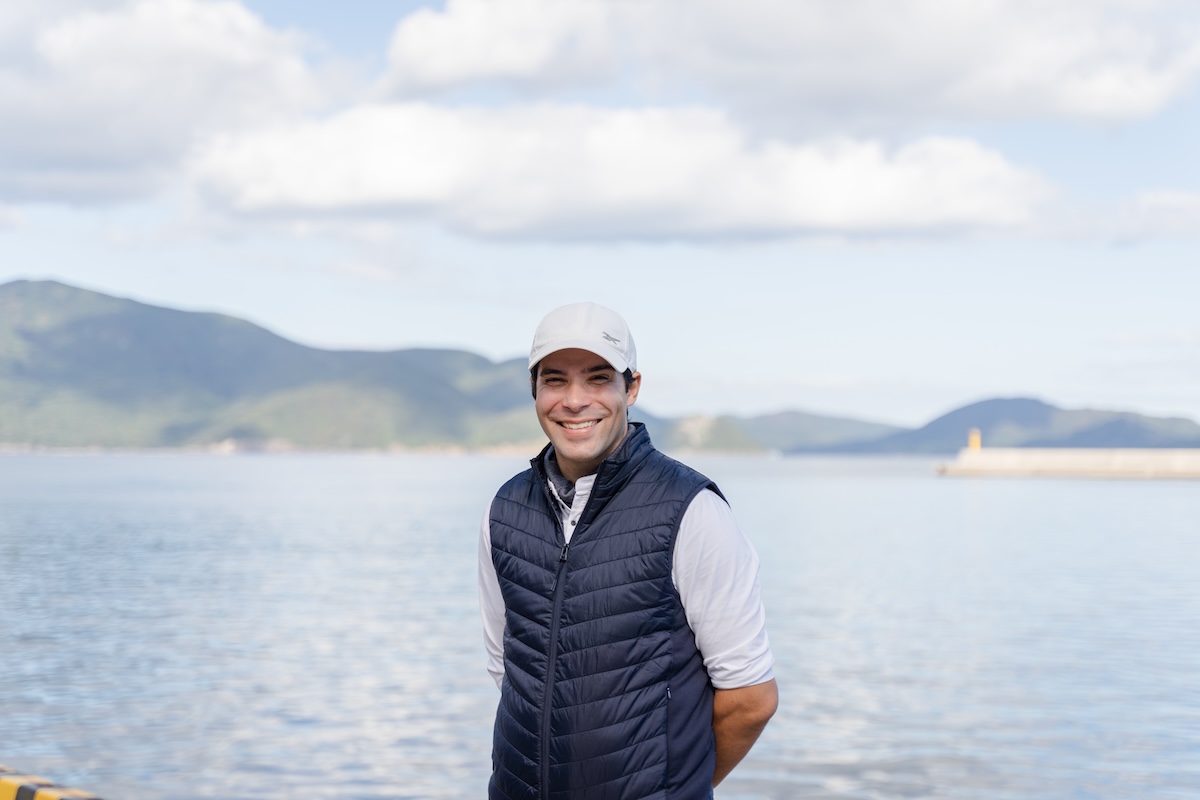Meet the Tour Guide: David
“Is it true that there are more Japanese racoon dogs (tanuki) than humans here?”
“The name of the island is similar to Ghibli, so it somehow feels nostalgic and fantasy-like.”
There is much more about Chiburijima Island that would make you want to talk about it.
With a population of less than 600, Chibu Village, located on Chiburijima Island, is the only village (municipality) in Shimane Prefecture. The tanuki, with their numbers far exceeding the human population, call the island their home. Other than the dreamy pastoral scenery, it also has impressive volcanic terrain, including the red cliffs known as “Sekiheki”.
Although it is the smallest of the four Oki Islands, This island is full of exciting charm, the guide David Gomez, who is from Lyon in southeastern France can speak four languages: French, Portuguese, English and Japanese
“There are only two caldera in the world that are filled with sea water like Dozen, by the way the word caldera means “pot” in Portuguese”
Fluent in Japanese, David delivers with humour and wit, spreading happiness as he guides us. His bright smile fits in well with the relaxing and easy-going atmosphere of Chiburijima Island.
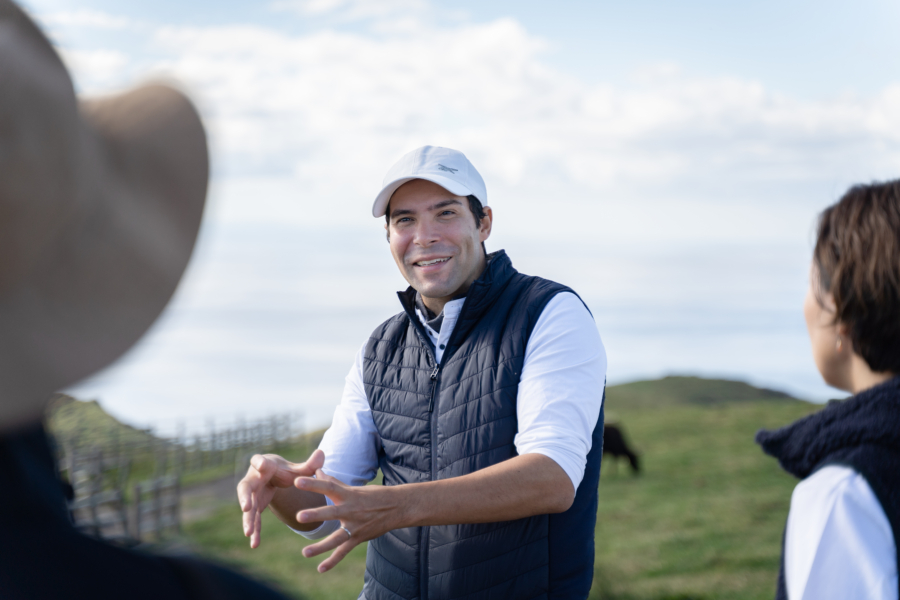
David and his wife have been living on Chiburijima Island for seven years. He initially worked as a chef at a hotel, but three years ago he began working as a guide and support staff at the Chiburijima Island Tourism association.
On the day of the interview, David brought us to Mt. Akahage, which is about 20 minutes by car from Kurii Port. Standing atop the highest peak on Chiburijima Island, you will be rewarded with a sweeping view of the Dōzen Caldera.
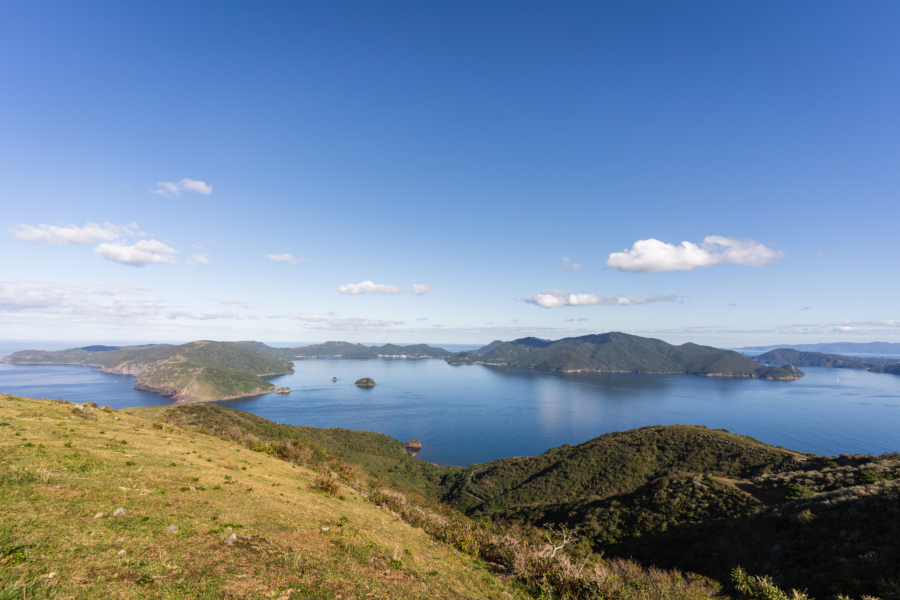
The inner sea of the Dōzen Islands stands out among the lush green surrounding the caldera. If you stand facing the north, the island on the left-hand side is Nishinoshima Island (Nishinoshima Town). On the right-hand side is Nakanoshima Island (Ama Town). Behind them on the horizon lies Dōgo Island (Okinoshima Town).
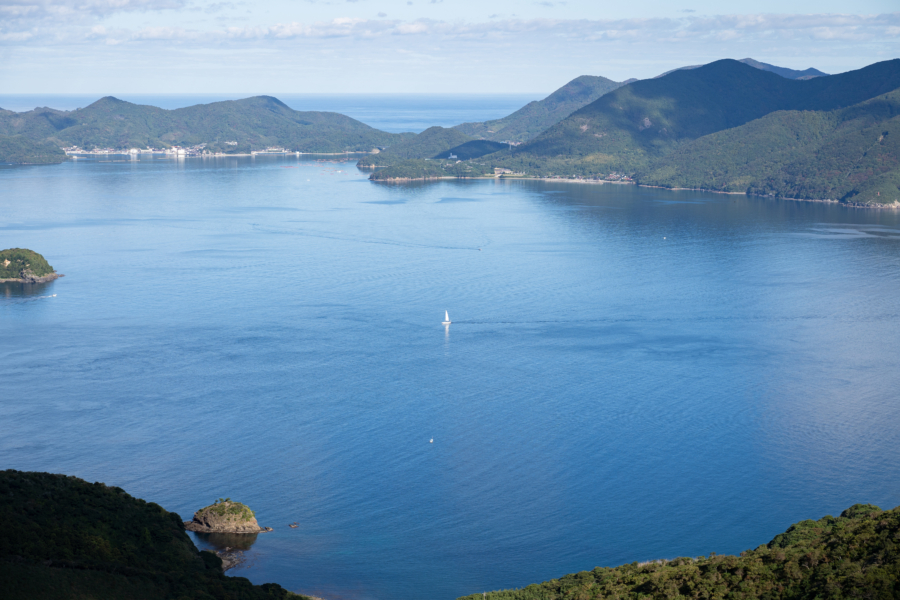
“This is Dōzen Caldera. Calderas are not rare, but this one is special. The land created by an undersea volcanic eruption collapsed, and sea water flowed into the basin due to erosion. The top part of the caldera rim remained above sea level, just like the rim of a ‘cooking pot’ (‘caldera’ in Portuguese). Not like a basin or a lake, but a caldera in the sea. in Japan and Santorini in Greece.”
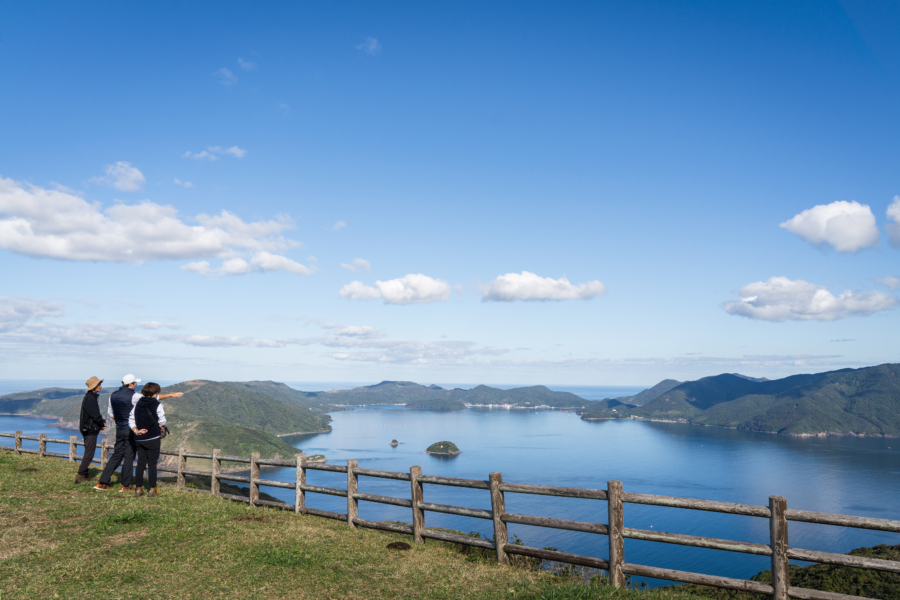
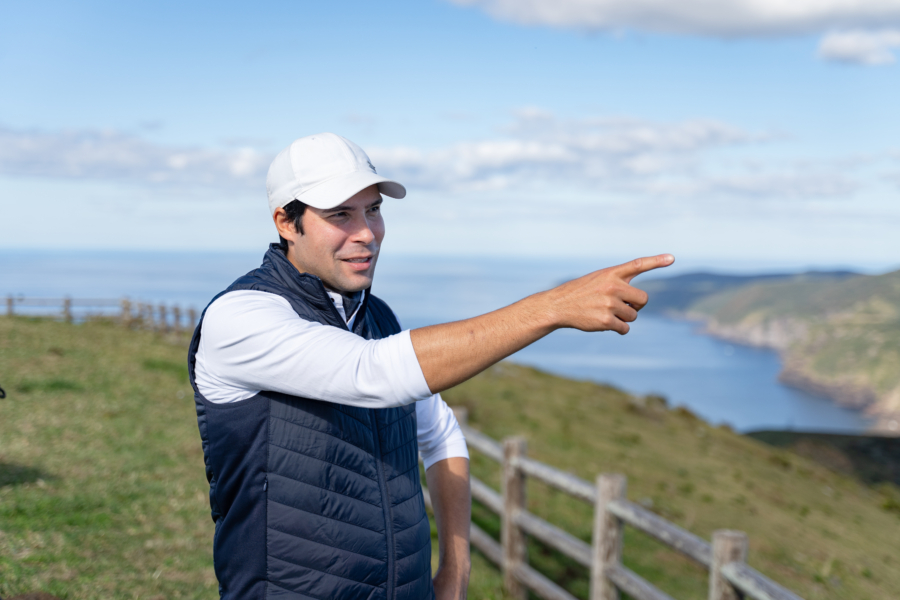
After enjoying our share of the scenery of the Dōzen Caldera, we walked along the gentle hills. It is said that Mt. Akahage (literally “crimson bald” in Japanese) got her name from the red soil and the lack of trees. Up until the mid-1960s, a rotary farming technique called Makihata was practised here. Remains of the Myogaki stone walls, which served as borders dividing the fields used for Makihata can still be seen here near the mountain peak.
As I was looking across the pasture where cows are grazing, a tanuki ran across the field. Just a few meters away from grazing cows are tanuki enjoying the rolling hills, a common sight in Chibu.
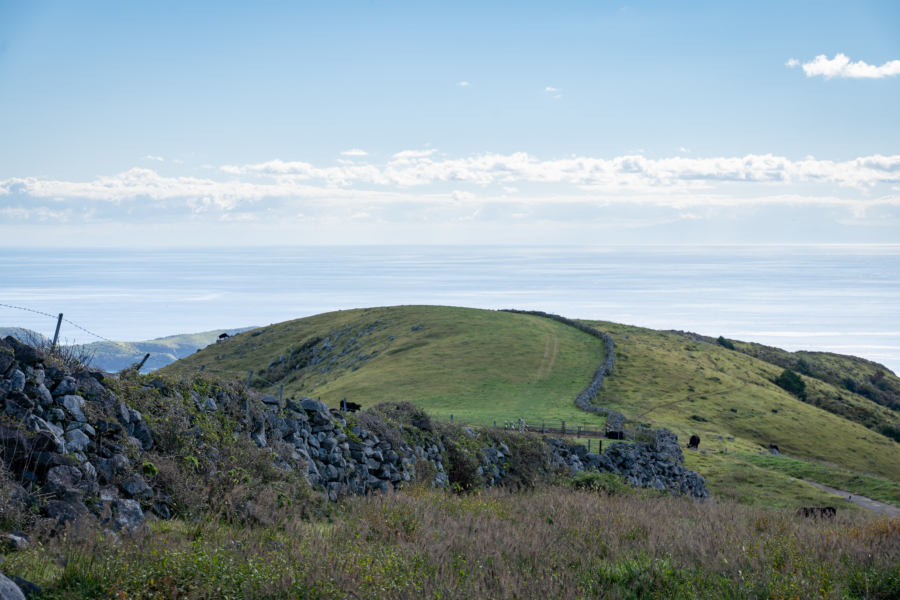
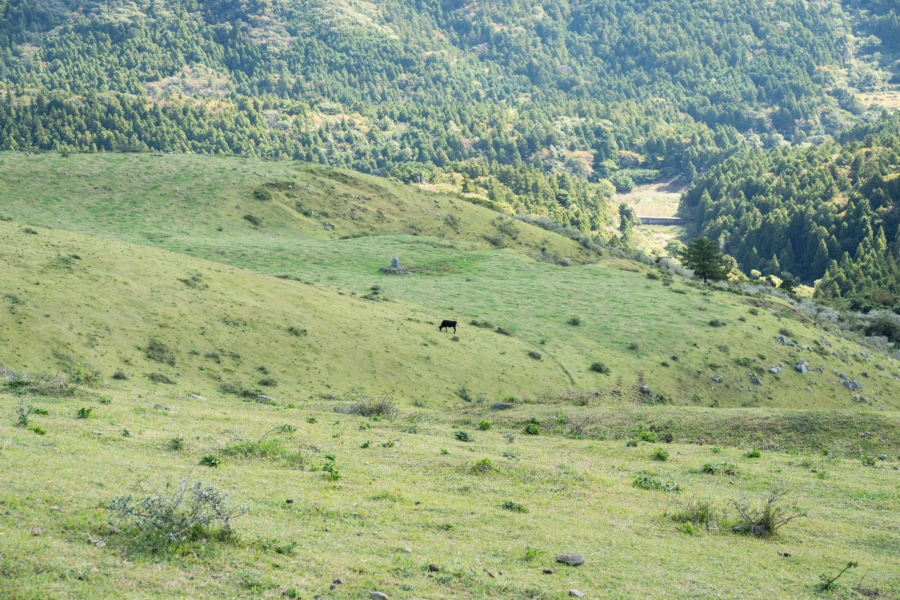
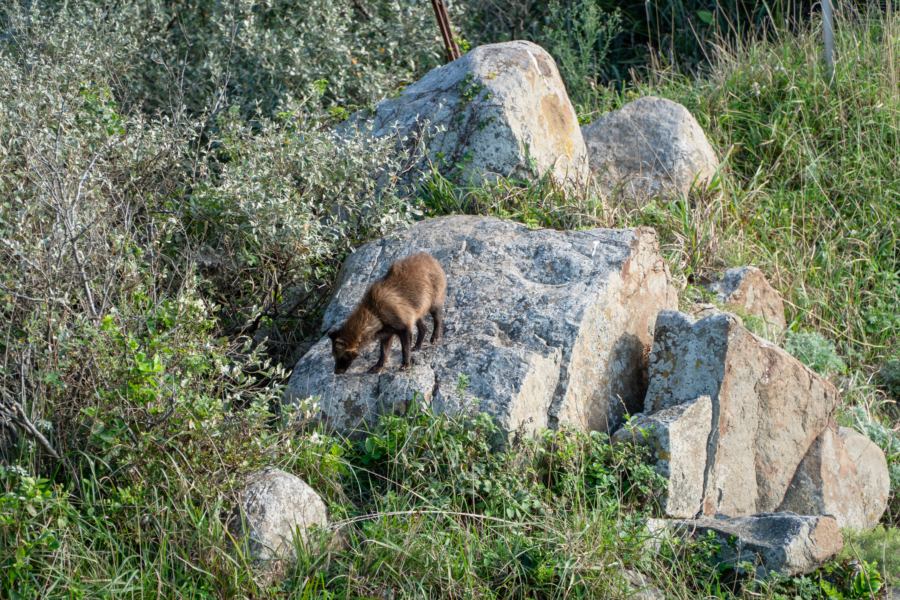
“There are a lot of cows grazing here, but no one brings them water, that’s because there are natural water springs. I think these natural water springs are the island’s greatest treasure. Without the natural flow of fresh water, humans could not reside here and animals cannot be kept. The second treasure are the cows. Without them, Makihata rotation farming would not of been possible. I think the rich, natural flow of water and cows created the history of this island.”
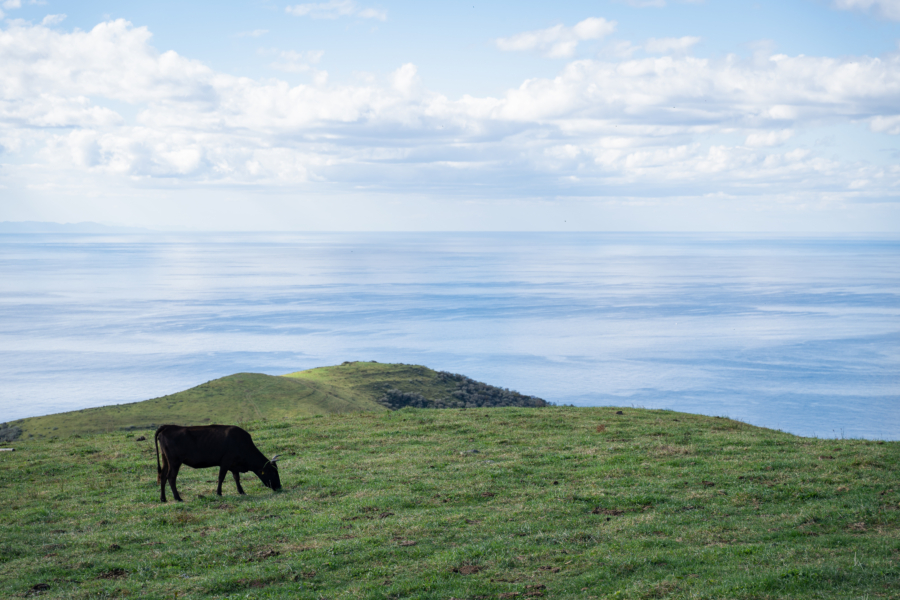
Just a few steps down the slope from the lookout, you will come across a small shrine. It is known as “Daisen-san” to the locals.
“The small shrine faces Mt. Daisen of Tottori Prefecture. On a clear day, you can see Mt. Daisen in front of you when you stand here. In the past, the largest livestock market in Japan was hosted on Mt. Daisen. Horses and cows from Chibu were also sold there, and it is said that this shrine was built by the locals as the guardian deity of their animals. After all, cows are special to the islanders.”
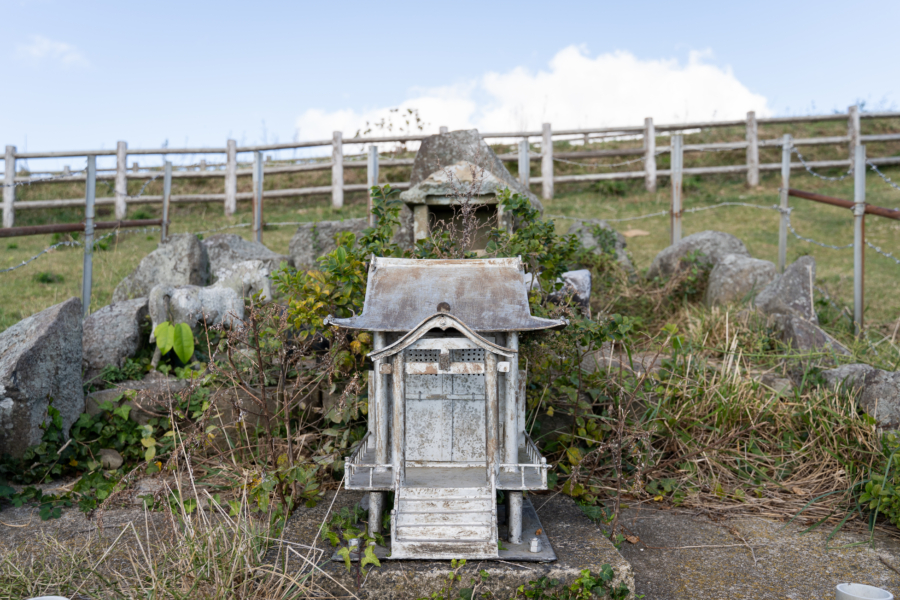
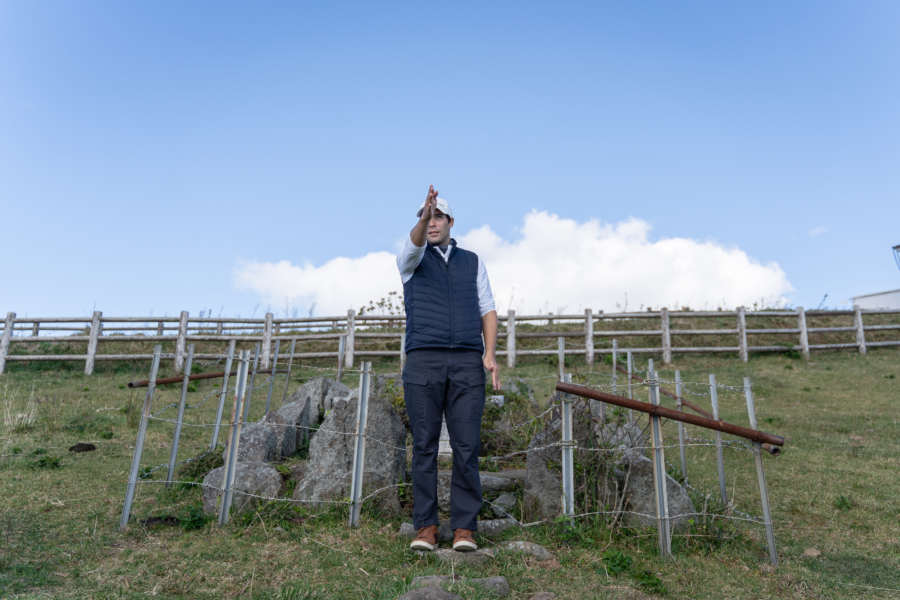
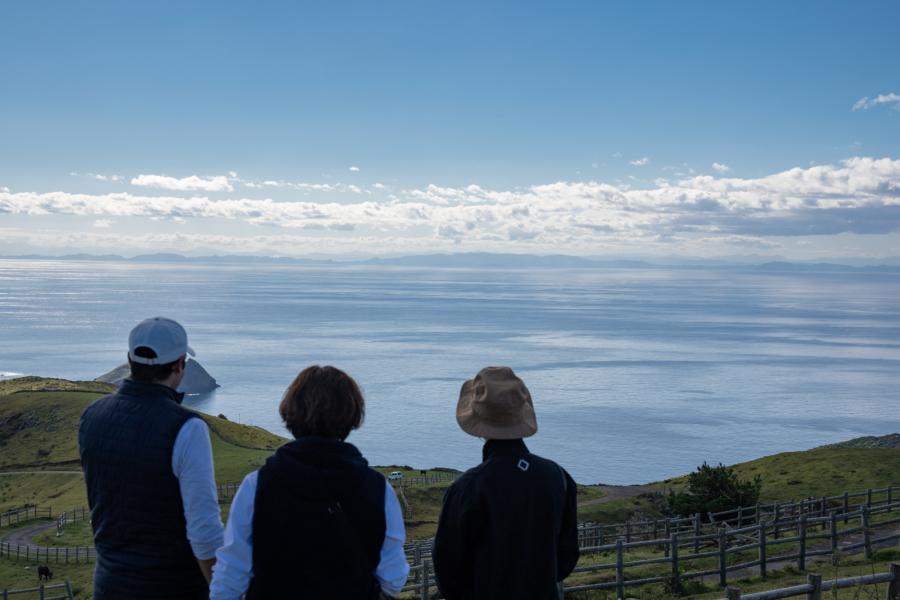
Regarding the huge number of tanuki on the island, “it is said that a pair were given to the village chief in 1941, they escaped and created numerous offspring. One of the estimates is that there are more than 2000 of them now.” Furthermore, the typically nocturnal tanuki are active during the day here on Chiburijima Island, “because there are no natural predators here on the island, they feel safe even during the daytime.” It’s a peaceful story that is very typical of Chiburijima.
David learned about the history of the tanuki on the island by reading the local historical document “Chio Village History.” As an animal lover who likes to dive deep when learning, he has become knowledgeable in the habits and ecology of the tanuki. He is constantly expanding his knowledge as a guide, through daily study, field observations and speaking with the locals he has gained vast insight into Chiburijima, not limited to just tanuki.
“I hope we can protect this islands environment, where animals and people live in harmony. The best thing about Chibu that I want to tell tourists about is it’s nature.” It also has warm-hearted people and traditional culture, creating a cozy and relaxed atmosphere, it feels like time has stopped here, but we are seeing an increase in new businesses, like restaurants. It’s very interesting.”
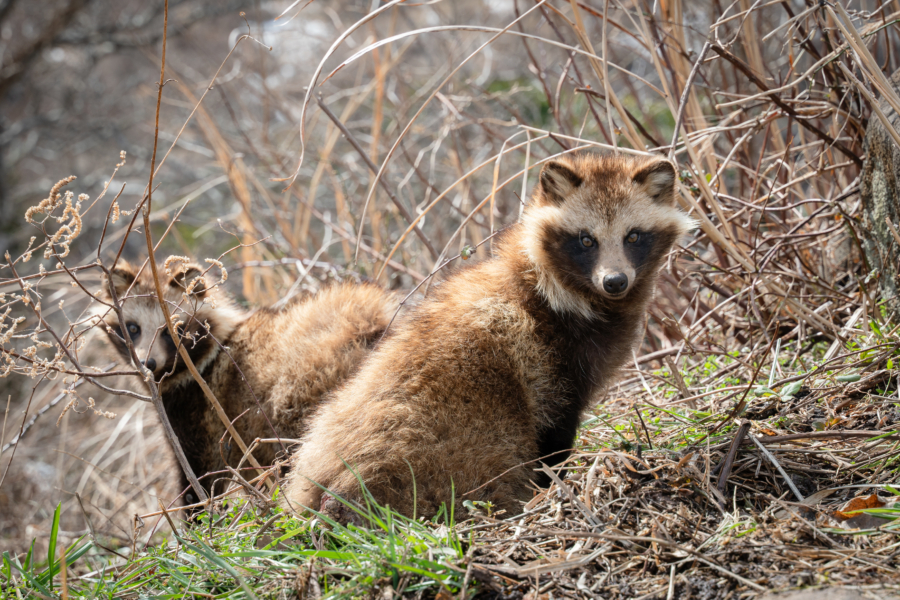
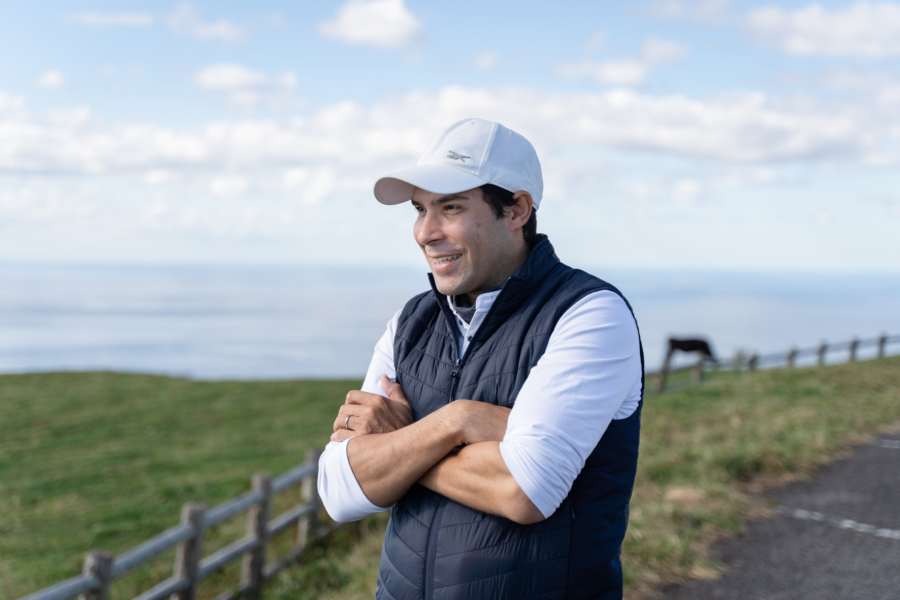
David was born in Lyon, a city in the southeast of France that is famous world wide for its cuisine. Japanese culture is popular in France, and the younger generation have become more interested in the culture because of anime and manga, but that was not the case for David.
“I admired Bushido and fell in love with Japan. There was a kendo school near where I lived. I started learning kendo there and that was how it all started. The instructor was not only a skilled kendo artist but also knowledgeable about Japanese culture in general. The more I listened to his talk, the more fascinated I became… I also watched a lot of films directed by Akira Kurosawa, and Rashomon is my favorite. Japan is fascinating in many ways, but I am still very interested in spiritual culture such as Bushido and history.”
David studied both Japanese language and culture at university. During his student days, he traveled around Japan for the first time and spent a month in the country, from this he became even more fascinated with Japan, following this he became an exchange student at Shimane University for a year. After returning to France and graduating, David pursued the culinary arts at a culinary institute in Lyon and gained experience at Têtedoie, a one star Michelin restaurant”, in 2015, he finally returned to Japan.
He ended up getting married in Japan, he had met his wife in Matsue city while working part-time during his studies abroad at Shimane University. Shimane lives up to its reputation as “the land of go-en (Fortuitous encounters).”
He initially worked at a hotel in Hiroshima city for two and a half years, the couple then decided to move to Chiburijima island, which by coincidence was the hometown of his wife’s grandmother.
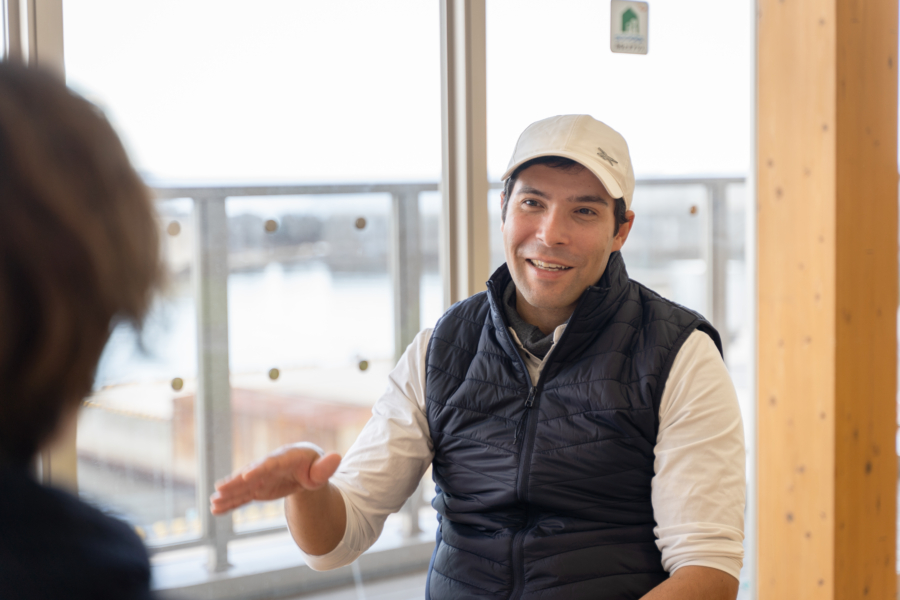
“At the time, a hotel on a neighboring island was looking for staff who could speak French, so I quit my job in Hiroshima City and moved to Oki in 2016, thanks again to go-en (Fortuitous encounters) brought about by my wife’s grandmother, we managed to rent a place and received a lot of help from the community. So I’m very grateful.”
David first worked at the hotel, but after their children were born he switched to a different career path. David is now working as a tour guide and supporting the staff at the tourism association. The Oki Islands receive a lot of visitors from Europe and North America. as a speaker of French, Portuguese, English and Japanese, David plays an exceptionally important role.
Having now lived in Japan for eight years, although the Oki dialect is not easy to understand, he has no trouble conversing in Japanese. He says this casually, but it is unmistaken that he has put a lot of effort into mastering the skill. He is, indeed, an avid learner.
“When I was a chef, I dedicated everything to the culinary arts. So, after becoming a tour guide, I studied Oki Islands and Chibu a lot. Take care of the basics, to do things thoroughly. To be considerate towards the things and people in front of you. I learned this from the Bushido’s way of thinking that I have admired since I was a child.”
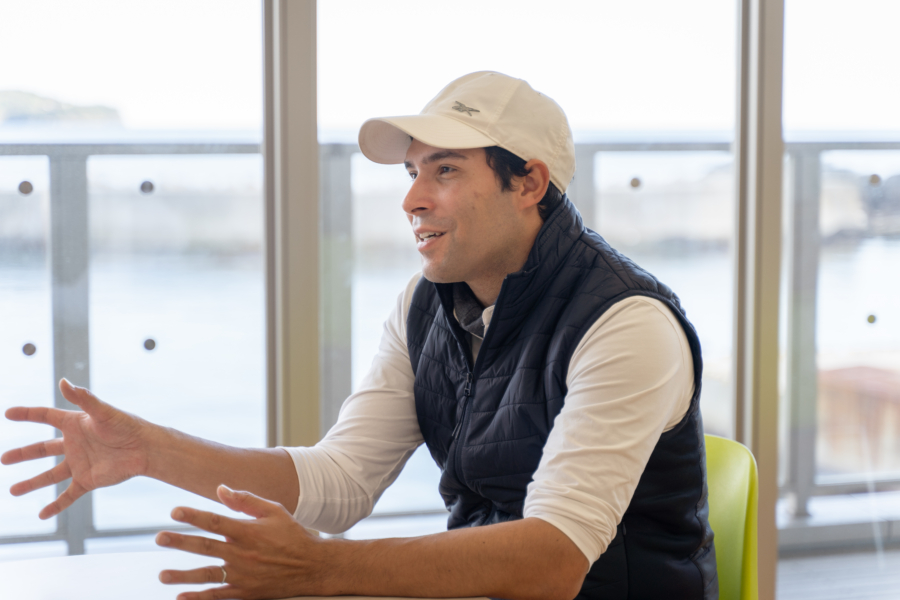
David has an idea in mind – starting a culture school where people can learn about the cultures of France and the Oki Islands. Domestic participants can learn French and the culture of France, whereas participants from overseas can learn more about Chibu, Oki Islands and Japan. He is looking forward to running such an academy.
“It is not in full swing yet, but we did launch in April. We teach cooking, dessert making, bread baking, language and etiquette. And occasionally Kendo. My schedule is filled with guiding tours at the moment, but I would like to find a good balance in the future so i can dedicate more time to this project in the future. I am so thankful that I have studied Japanese language and Japanese culture before coming to this island. As a chef, all my focus was on cooking. but in guiding and at the cultural school I have made use of all my experiences and what I have learnedt up till now. I’ve always loved nature and animals, so right now I’m really enjoying my current job. I am so glad that everything I have learned and done is showing its meaning.”
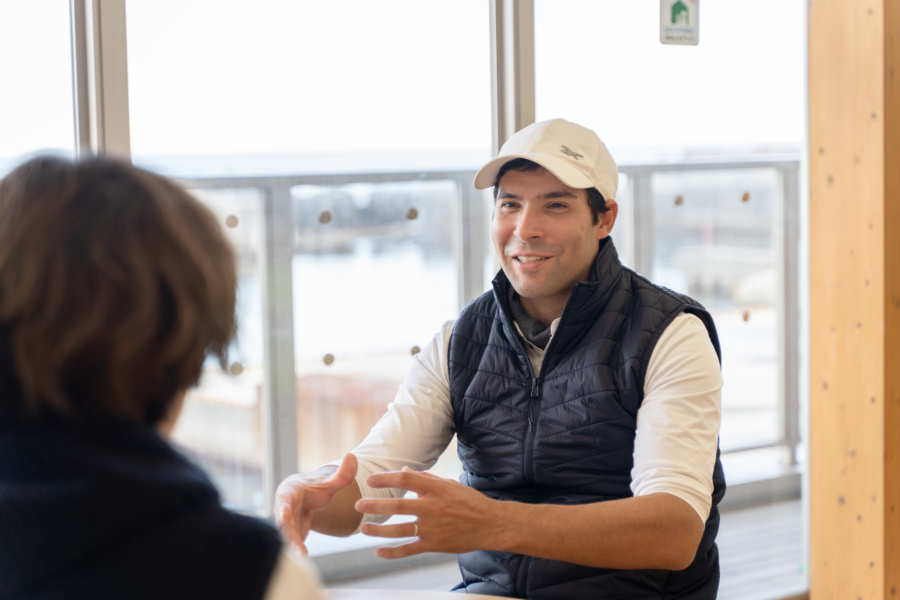
In the past few years, mouth-watering eateries have been popping up on the island: a stylish café run by a cattle farmer, a ramen shop specializing in shrimp broth run by a new islander, a baked goods shop etc. Out of all the new locations, David especially recommends Chez SAWA, a French restaurant established in 2022 that uses Chibu-grown ingredients. The Japanese chef of Chez SAWA is one of Chibu’s new islanders, but “it turns out he did his culinary training at Têtedoie, the restaurant I worked at. What a coincidence!”, says David. Once again, go-en worked its magic.
We asked David for a special sightseeing plan that will allow visitors to fully enjoy Chiburijima Island.
“For a short 2-day trip. You could arrive at Kurii Port just before noon, so I would suggest going to Don Don, a small eatery specialized in seafood, for lunch. Their asazuke-don (pickled vegetables on rice) is filling and delicious! After lunch, you can get on an e-bike and ride to Sekiheki (Red Cliff) and Mt. Akahage. Then head to Chez SAWA for dinner and stay at Hotel Chibu-no-sato. On the next day, you can continue your e-bike journey or enjoy marine activities for some summer fun. The 50-minute sightseeing cruise operated by the sightseeing boat, Benten-maru, is also very enjoyable. On the sightseeing boat, you get to see Sekiheki from the bottom of the cliff. The scenery is so different compared to when you look down from the lookout on the cliff; you will be surprised! You can see the vermilion and black layers very clearly, which helps to understand the formation of the island. I recommend joining the guided sightseeing cruise. The cruise operates throughout the year as long as weather permits!”
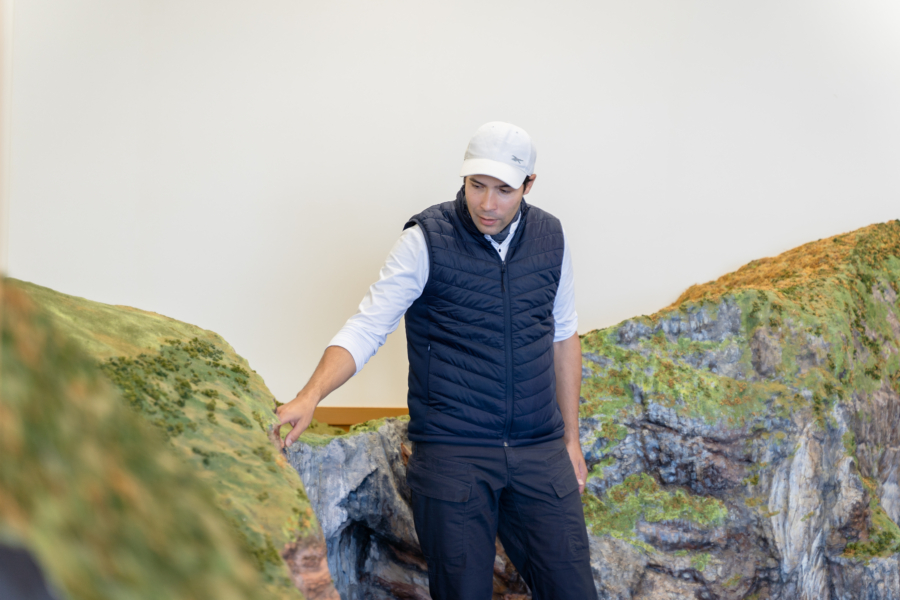
David explaining the formation of Sekiheki (Red Cliff) using the landscape model.

A bird’s-eye view of Sekiheki (captured using a drone)
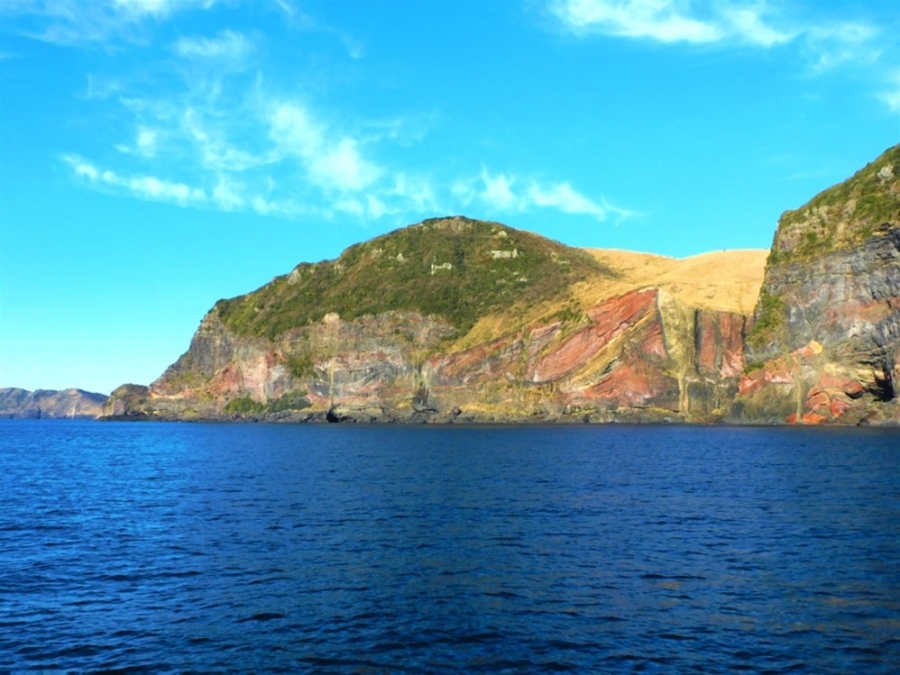
You can feast your eyes on the entirety of Sekiheki from the sea.
In spring 2023, Chiburijima Tourism Association introduced sea kayaking to their tours. There are also plans to increase the number of e-bike tours that visit scenic spots, temples and shrines.
Until now, it has been said that sightseeing in Chibu is visiting Sekiheki and Mt. Akahage. Both are picturesque and impressive, it is true that these two are crucial to Chibu’s tourism. However, the island has more to offer. David emphasizes that he wants to change this traditional pattern of tourism.
“I want our visitors to spend some quality time here in Chibu, since they have already come all the way to the Oki Islands. But in order to do this, we have to come up with products that are attractive to them. I think my culture school can play a significant role there. No matter if you’re a domestic tourist or an international visitor, you will want to spend a few days here, just for this purpose. It would be great if participants could get to know more about Japanese and French cultures, surrounded by this beautiful environment.
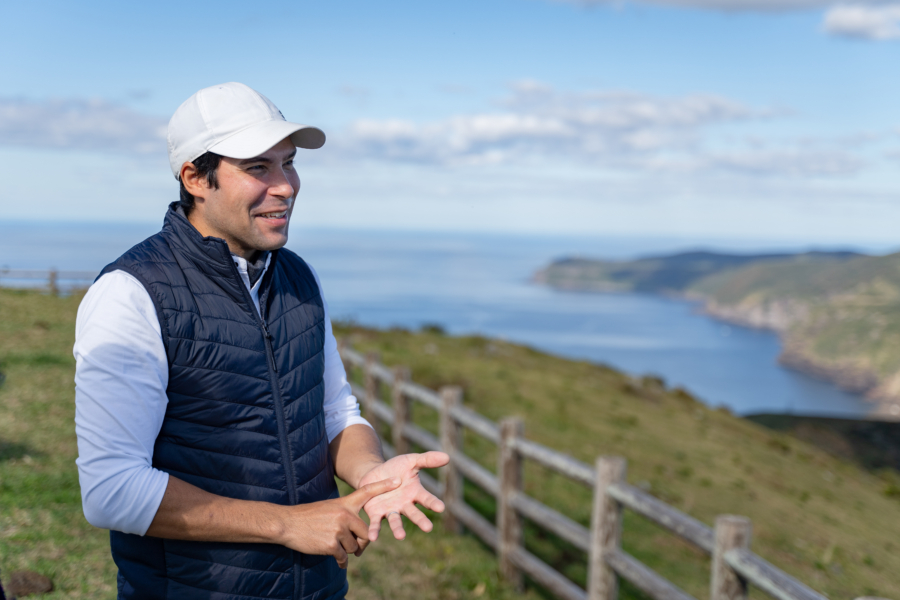
David’s desire to improve as a tour guide is endless. With each introduction of a new experience-based program, such as sea kayaking, there will be a need to acquire the technique as an instructor and knowledge for safety management. David takes it very seriously.
“I want to know more about the plants on the islands such as the flowers of Oki, and I want to increase the variety of marine activities. There are many things I want to do to boost customer satisfaction. We don’t receive as many tourists compared to other major tourist destinations such as Tokyo and Kyoto. But this is also the reason why I want to treat each of our customers wholeheartedly and with care.”
David’s admiration for Japanese culture, starting with Bushido, and his love for the island gave birth to his unique hospitality style. Be sure to visit Chiburijima Island and meet David!
(Interview by Marie Kosaka, translation from Japanese by Cleo Wong)
David’s Favourite Location: Mt. Akahage
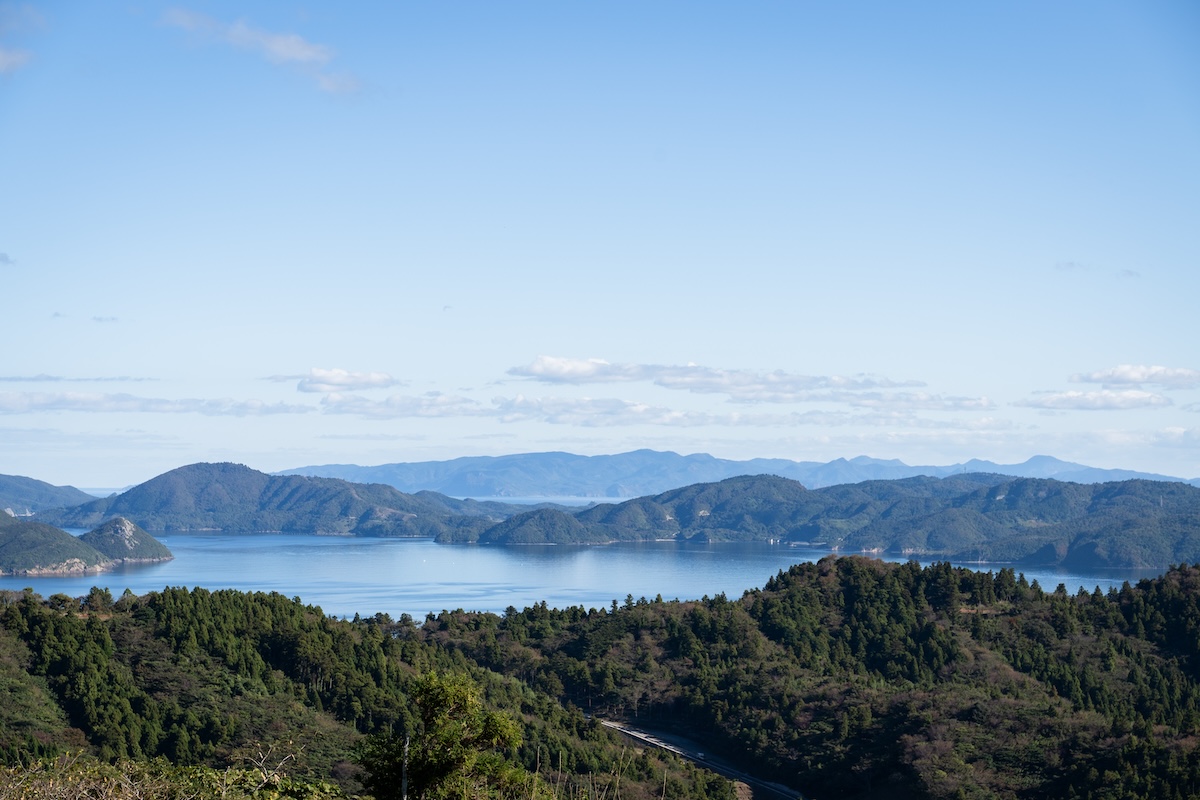
There is a Texas gate (cattle grid) near the lookout on Mt. Akahage, marking the entrance of the pasture. It is just a few steps from the grid; the view of Dōzen Caldera from there is my favorite.
Dōzen is a caldera partly submerged in the sea. The outer rim of the caldera was carved by erosion and sea water entered. The formation of the inland sea made this landscape very unusual. If you look from here, you can easily imagine how the caldera looked after the eruption and before the seawater entered. It is also easier to explain to visitors the formation of the Dōzen Islands here.
That is my favorite spot on the land, and my number one spot at the sea is the sea cave on the southern side of Shimazushima Island. You can’t get there on foot; it is only reachable by kayak or SUP. The ceiling of the cave is so low that I can feel my head touching it. This unique landscape can only be found here. I can bring you there if you are an experienced sea kayaker.

